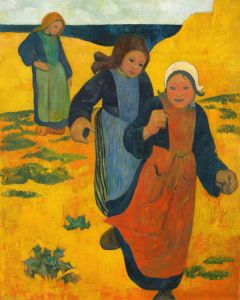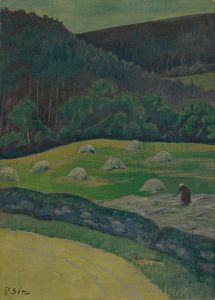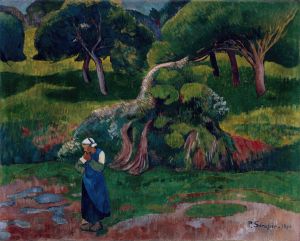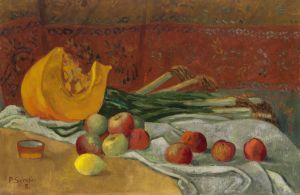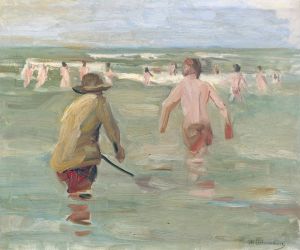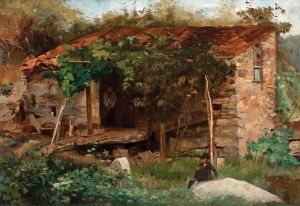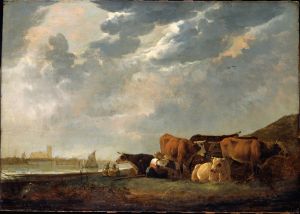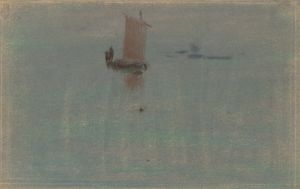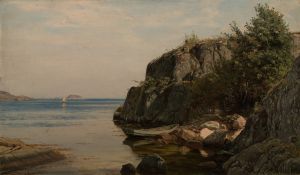
The Beach of Les Grands Sables at Le Pouldu
A hand-painted replica of Paul Sérusier’s masterpiece The Beach of Les Grands Sables at Le Pouldu, meticulously crafted by professional artists to capture the true essence of the original. Each piece is created with museum-quality canvas and rare mineral pigments, carefully painted by experienced artists with delicate brushstrokes and rich, layered colors to perfectly recreate the texture of the original artwork. Unlike machine-printed reproductions, this hand-painted version brings the painting to life, infused with the artist’s emotions and skill in every stroke. Whether for personal collection or home decoration, it instantly elevates the artistic atmosphere of any space.
Paul Sérusier's painting "The Beach of Les Grands Sables at Le Pouldu" is a notable work that reflects the artist's involvement with the Pont-Aven School and his exploration of Symbolism and Synthetism. Sérusier, a French painter born in 1864, was a key figure in the post-Impressionist movement and played a significant role in the development of modern art in France.
The painting depicts the beach of Les Grands Sables, located in Le Pouldu, a small village in Brittany, France. This region was a popular destination for artists in the late 19th century, particularly those associated with the Pont-Aven School, which included artists like Paul Gauguin and Émile Bernard. The natural beauty and unique light of Brittany attracted these artists, who sought to break away from the conventions of Impressionism and explore new artistic expressions.
Sérusier's work is characterized by its bold use of color and simplified forms, elements that are evident in "The Beach of Les Grands Sables at Le Pouldu." The painting captures the serene and expansive quality of the beach, using broad areas of color to convey the landscape's essence rather than its detailed appearance. This approach aligns with the principles of Synthetism, which emphasized the synthesis of form and color to express the artist's emotional response to a subject.
The influence of Paul Gauguin is particularly notable in Sérusier's work. Gauguin's emphasis on flat planes of color and symbolic content had a profound impact on Sérusier, as seen in this painting. Sérusier's use of vibrant, non-naturalistic colors and his focus on the emotional and spiritual aspects of the landscape reflect the teachings of Gauguin and the broader Symbolist movement.
"The Beach of Les Grands Sables at Le Pouldu" is also significant for its contribution to the development of the Nabis, a group of avant-garde artists that Sérusier helped to found. The Nabis, which included artists like Pierre Bonnard and Édouard Vuillard, were influenced by Sérusier's ideas and his emphasis on the decorative and symbolic potential of painting. This painting, with its emphasis on mood and atmosphere, exemplifies the Nabis' interest in moving beyond naturalistic representation to explore more abstract and expressive forms.
The painting is an excellent example of Sérusier's mature style, showcasing his ability to distill a scene into its essential elements while imbuing it with a sense of mystery and depth. The composition is carefully balanced, with the expansive beach leading the viewer's eye towards the horizon, creating a sense of infinite space and tranquility.
Today, "The Beach of Les Grands Sables at Le Pouldu" is appreciated not only for its aesthetic qualities but also for its historical significance in the context of late 19th-century art movements. It represents a pivotal moment in the transition from Impressionism to more abstract and symbolic forms of expression, highlighting Sérusier's role as a bridge between these artistic currents.
Overall, Paul Sérusier's "The Beach of Les Grands Sables at Le Pouldu" remains an important work for its innovative use of color and form, its reflection of the artistic trends of its time, and its enduring influence on subsequent generations of artists.





